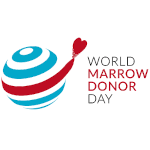World Marrow Donor Day Date in the current year: September 20, 2025
 World Marrow Donor Day is observed annually on the third Saturday of September. It was created to celebrate all hematopoietic stem cell donors across the world, as well as to raise awareness of the importance of bone marrow transplant for saving patients’ lives.
World Marrow Donor Day is observed annually on the third Saturday of September. It was created to celebrate all hematopoietic stem cell donors across the world, as well as to raise awareness of the importance of bone marrow transplant for saving patients’ lives.Bone marrow plays a critical role in the production of new blood cells (haematopoiesis). It contains a large number of hematopoietic stem cells that give rise to other blood cells, such as erythrocytes, lymphocytes, and different types of platelets (thrombocytes). In the mid-20th century, scientists began considering the idea of transplanting bone marrow cells from healthy people to patients whose bone marrow can’t properly produce blood cells.
In 1958, French oncologist and immunologist Georges Mathé became the first person to perform a successful allogenic bone marrow transplant on unrelated human beings to save Yugoslav nuclear workers whose own marrow had been damaged by radiation during a criticality incident at the Vinča Institute of Nuclear Sciences. Although the patients’ bodies rejected the transplants, five of the six workers ultimately recovered.
The first successful bone marrow transplant between persons who were not identical twins was performed by American physician Robert A. Good in 1968. His team transplanted bone marrow from an 8-year-old girl to her 5-month-old brother with a profound immune deficiency. Another American physician, E. Donnall Thomas, developed bone marrow transplantation as a leukemia treatment with the assistance from his wife and research partner Dottie. In 1990, he received the Nobel Prize in Physiology or Medicine for his discovery.
These days, tens of thousands bone marrow transplantations are performed around the world every year. The procedure is used to treat patients with life-threatening diseases, such as cancer (leukemias, lymphomas, solid tumor cancers), hematologic diseases (phagocyte disorders, anemias, myeloproliferative disorders), autoimmune diseases, radiation poisoning, HIV, and more.
Since transplanted hematopoietic stem cells can be rejected by the recipient’s body, it is crucial to find a compatible donor. Unlike blood transfusion, which only requires a compatible blood type that is relatively easy to find, bone marrow transplantation requires HLA (human leukocyte antigen) compatibility. About 25 to 30 percent of all donors are recipients’ siblings, but what if a patient doesn’t have a closely HLA matched sibling?
This is when bone marrow donor registries come to the rescue. A person willing to donate their hematopoietic stem cells can undergo HLA-testing and have their information added to a registry. Since the likelihood of finding a suitable donor within the recipient’s country isn’t always high, especially in countries with small populations and insufficient awareness of the importance of bone marrow donation and donor registries, the World Marrow Donor Association (WMDA) was created to help people find matching donors.
WMDA has created the largest bone marrow donor database, which, as of 2020, includes almost 38 million donors from more than 50 countries. Thanks to the database, people who need bone marrow transplant have a higher chance to find a compatible donor, if not from their own country, then at least from their region.
WMDA initiated World Marrow Donor Day to raise awareness of the importance of bone marrow transplantation and the creation and maintenance of donor registries among potential donors, healthcare professionals, government officials, and the general public.
- Category
- International Observances
- Tags
- World Marrow Donor Day, World Marrow Donor Association, international observances, bone marrow donors, bone marrow transplant